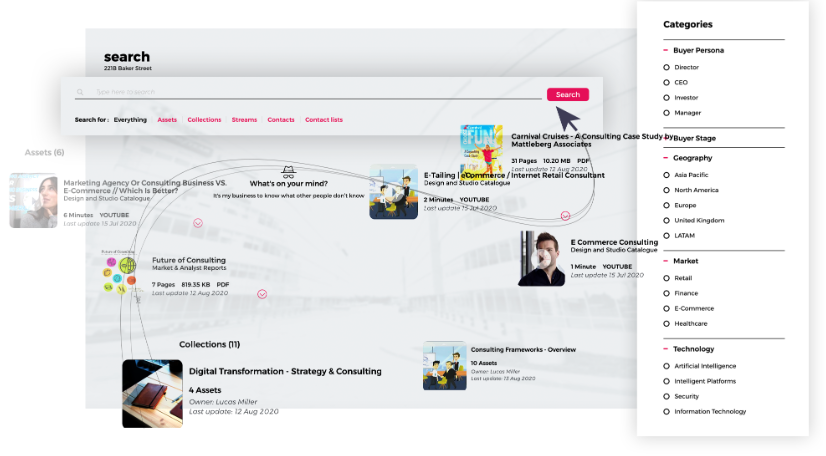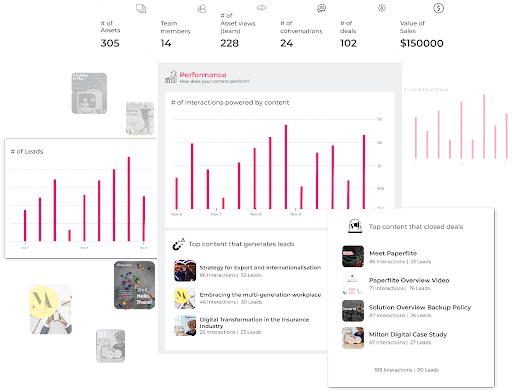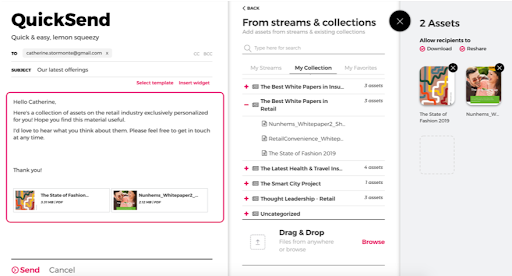What is digital asset management life cycle ?
By effectively organizing and managing your digital assets, you can unleash their full potential. Instant access, seamless collaboration, and effortless sharing you can make the best usage of your assets
you've got a treasure trove of captivating images, killer videos, and persuasive documents that could make even the toughest customer weak in the knees.
These digital assets are your secret weapons, the ammunition that fuels your marketing and sales success. They have the power to captivate, persuade, and close deals like magic.
But here's the thing: without proper storage and management, your precious digital assets can easily go astray, lost in the chaotic digital wilderness. It's like misplacing your lucky charm right before a big pitch - yikes! That's where digital asset management swoops in to save the day.
By effectively organizing and managing your digital assets, you can unleash their full potential. Instant access, seamless collaboration, and effortless sharing become your superpowers.
You'll have your marketing campaigns firing on all cylinders and your sales pitches hitting the bullseye every time.
What is a digital asset lifecycle?
The digital asset lifecycle refers to the various stages that a digital asset goes through from its creation to its eventual refinement. It encompasses the processes involved in managing, distributing, analyzing, and refining digital assets to maximize their value and effectiveness.
Creation:
In the context of marketing and sales, the creation stage involves developing digital assets that support promotional and sales efforts. Marketing teams may create assets like graphics, videos, blog posts, or social media content to engage with the target audience and build brand awareness.
Sales teams may contribute by creating sales collateral, product demos, or presentations to showcase the value and features of products or services. Collaboration between marketing, sales, and other teams ensures that the assets align with the overall marketing strategy and meet the needs of the sales process.
Make Content That Is Bingeable And Not Boring
Management:
Efficient management of digital assets is crucial for seamless collaboration between marketing and sales teams. Marketing teams can organize and maintain assets in a central digital asset management system, making it easy for sales teams to access the latest materials.
Tagging assets with relevant metadata and categorizing them based on target audience, product/service, or campaign helps streamline asset discovery and retrieval. By implementing version control and permissions management, teams can ensure that everyone has access to the most up-to-date and approved assets.

Distribution:
Marketing and sales teams work together to distribute digital assets effectively. Marketing teams leverage various channels such as websites, social media platforms, email marketing, or advertising to reach the target audience. Sales teams utilize assets during presentations, meetings, or follow-ups with prospects or clients.
Collaborative efforts between marketing and sales ensure that assets are distributed through the most suitable channels and touchpoints, aligned with the customer journey, and effectively support sales activities.
Analytics:
Both marketing and sales teams benefit from leveraging analytics in the digital asset lifecycle. Marketing teams analyze metrics such as website traffic, social media engagement, conversion rates, or lead generation to assess the performance of marketing campaigns and assets.
Sales teams can leverage analytics to track the usage of sales collateral, identify which assets are most effective in influencing prospects, or measure the impact of assets on the sales pipeline. Data-driven insights from analytics help marketing and sales teams refine their strategies, optimize assets, and allocate resources effectively.
Get Actionable Insights That Moves Sales Forward
Refinement:
Refinement based on analytics feedback is crucial for continuously improving digital assets. Marketing teams can use insights from analytics to refine the content, design, or distribution strategy of assets, ensuring they resonate better with the target audience.
Sales teams can provide feedback on the effectiveness of assets in addressing customer objections or enhancing sales conversations. Collaboration between marketing, sales, and other teams allows for valuable input and iterative improvements to digital assets, ensuring they remain relevant, impactful, and aligned with organizational goals.
By aligning the stages of the digital asset lifecycle with the activities of marketing, sales, and other teams within an organization, efficient collaboration and synergy can be achieved. This leads to improved asset effectiveness, enhanced customer engagement, and increased sales and marketing performance.
Overview of common challenges faced in managing digital assets:
Managing digital assets can present several challenges that impact multiple teams within an organization. Some common challenges include:
Lack of version control: Difficulty in tracking and managing different versions of digital assets, leading to confusion and potential use of outdated or incorrect materials.
Inconsistent metadata and tagging: Inadequate organization and inconsistent metadata make it challenging to search, retrieve, and categorize digital assets effectively.
Limited visibility and accessibility: Assets stored in disparate locations or on individual devices hinder accessibility and collaboration across teams, leading to delays and inefficiencies.
Compliance and legal considerations: Ensuring compliance with copyright laws, licensing agreements, and usage rights can be complex, and failure to do so may result in legal issues or reputational damage.
Lack of organization and structure:
Marketing, sales, design, and other teams often face challenges in maintaining organized and structured digital asset repositories. This can result in:
Difficulty in locating assets: Team members waste time searching for specific assets, leading to reduced productivity and delays in marketing campaigns or sales processes.
Replication of assets: Lack of visibility into existing assets may lead to the creation of duplicate or similar assets, wasting resources and creating confusion.
Inefficient collaboration: Without proper organization and structure, collaborating on assets becomes challenging, leading to miscommunication and potential inconsistencies in branding or messaging.
Difficulty in accessing and distributing assets:
Various teams encounter challenges when accessing and distributing digital assets efficiently. This can manifest as:
Access restrictions: Lack of clear permissions and access controls may result in team members being unable to access the assets they need, hindering their work.
Inefficient distribution channels: Teams may struggle to identify the most appropriate channels for distributing assets, resulting in suboptimal reach and impact.
File format compatibility: Incompatibility between different file formats or software tools can make it difficult to share or use assets across teams, causing delays and technical issues.
Analyzing asset performance and deriving meaningful insights:
Teams often face challenges in analyzing the performance of digital assets and deriving actionable insights. This can include:
Lack of standardized metrics: Teams may struggle to define and track relevant metrics to evaluate the effectiveness of assets, making it difficult to gauge their impact.
Limited data visibility: Inadequate tracking or reporting systems may limit access to data on asset performance, hindering the ability to make informed decisions.
Incomplete analytics integration: Insufficient integration between analytics tools and digital asset repositories may hinder the ability to gather comprehensive insights and connect asset performance to business outcomes.
Incorporating feedback and refining assets based on analytics:
Teams can encounter challenges in effectively incorporating feedback and refining assets based on analytics insights. This can result in:
Siloed feedback loops: Lack of communication and collaboration between teams can impede the flow of feedback and hinder the improvement of assets based on user insights.
Resistance to change: Team members may be hesitant to implement changes or refine assets based on analytics feedback, resulting in missed opportunities for optimization.
Limited resources and prioritization: Resource constraints and competing priorities may limit the ability to allocate time and effort towards refining assets based on analytics insights, leading to stagnant asset performance.
By addressing these challenges and implementing effective digital asset management strategies, organizations can empower marketing, sales, design, and other teams to overcome these obstacles, improve efficiency, and drive better outcomes.
Introduction to Digital Asset Management (DAM):
Digital Asset Management (DAM) is a system or software that allows organizations to store, organize, retrieve, and distribute digital assets efficiently. It provides a centralized hub for managing all types of digital assets, such as images, videos, documents, and more.
Benefits of implementing DAM in managing digital assets:
- Enhanced efficiency: DAM streamlines workflows, reduces manual tasks, and automates processes, enabling teams to work more efficiently and save time.
- Improved collaboration: DAM facilitates collaboration by providing a central platform where teams can easily share, review, and provide feedback on digital assets, promoting cross-functional collaboration and reducing communication gaps.
- Enhanced brand consistency: DAM ensures that teams have access to the latest approved assets, enforcing brand guidelines and reducing the risk of using outdated or inconsistent materials.
- Increased productivity: With DAM, teams spend less time searching for assets, as they can quickly locate and retrieve them using robust search and metadata capabilities. This boosts productivity and allows teams to focus on their core responsibilities.
Addressing organization and structure challenges with DAM:
DAM helps address challenges related to organization and structure by:
Centralizing assets: DAM provides a single repository where teams can store and organize digital assets, ensuring a structured and organized asset library accessible to authorized users.
Tagging and metadata management: DAM enables the application of metadata and tags to assets, making it easier to search, categorize, and retrieve assets based on various criteria, such as keywords, file types, or usage rights.
Version control: DAM tracks different versions of assets, ensuring that teams have access to the latest versions and reducing confusion or reliance on outdated materials.
Streamlining access and distribution through DAM:
DAM simplifies access and distribution of digital assets by:
Permissions and access controls: DAM allows teams to set granular permissions, ensuring that only authorized users can access, download, or modify specific assets, safeguarding sensitive or restricted content.
Efficient sharing and distribution: DAM provides secure and streamlined methods for sharing assets internally or externally, eliminating the need for manual file transfers and ensuring consistent and controlled distribution across teams and channels.
Format conversion and delivery: DAM can automatically convert assets into different formats or resolutions to accommodate various usage requirements, making it easier to distribute assets in the most appropriate format for different channels or devices.
Utilizing analytics and data-driven insights with DAM:
DAM enables teams to utilize analytics and data-driven insights by:
Integration with analytics tools: DAM can integrate with analytics platforms to track and measure asset performance, providing valuable data on asset usage, engagement, and conversions.
Performance tracking and reporting: DAM allows teams to monitor key metrics and generate reports on asset performance, enabling data-driven decision-making and the identification of high-performing assets or areas for improvement.
Data-driven asset optimization: With analytics insights, teams can refine assets based on user behavior, preferences, or performance data, ensuring continuous improvement and increasing the effectiveness of digital assets.

Incorporating feedback and refining assets effectively with DAM:
DAM facilitates the incorporation of feedback and effective asset refinement by:
Collaborative review and approval workflows: DAM provides features for teams to collaborate on asset review and approval processes, streamlining feedback collection, and ensuring a structured and efficient feedback loop.
Version control and updated assets: DAM maintains a history of asset versions and changes, allowing teams to track feedback and changes made to assets over time, ensuring transparency and enabling
Paperflite as your DAM software:
Paperflite is a comprehensive digital asset management and content enablement platform that can significantly streamline and optimize your digital asset lifecycle. At the creation stage, Paperflite provides a centralized platform where teams can easily upload various digital assets like presentations, documents, and videos.
Organizing and categorizing assets using folders and tags ensures efficient asset creation and management.
In the management stage, Paperflite helps you maintain a well-structured library of digital assets. You can add metadata, descriptions, and keywords to assets, facilitating easy search, retrieval, and effective asset management.
When it comes to distribution, Paperflite simplifies the process by enabling the distribution of digital assets to internal and external stakeholders. You can create personalized collections or folders of assets for different teams or target audiences.
The platform offers multiple sharing options, including links, email campaigns, and integrations with collaboration tools like Slack, ensuring smooth and efficient asset distribution.

Paperflite also provides robust analytics capabilities during the analytics stage. You can track user engagement, views, downloads, and other relevant metrics to gain insights into asset performance.
Detailed analytics reports empower you to measure the effectiveness of assets and optimize your content strategy accordingly.
In the refinement stage, Paperflite efficiently lets you to refine assets based on user input and analytics insights.
By leveraging Paperflite throughout the digital asset lifecycle, you can streamline your processes, enhance collaboration, gain valuable insights, and continuously refine your assets, ultimately driving the success of your content strategy and empowering your teams to achieve their goals.
Additionally, Paperflite offers features beyond the digital asset lifecycle that can enhance your content enablement efforts. These include content personalization, real-time notifications, content recommendation engine, and seamless integrations with CRM and marketing automation platforms.
Conclusion:
In this digital age, where digital assets reign supreme, effective management is the key to unlocking their full potential. By understanding the digital asset lifecycle and the challenges that come with it, you're well on your way to maximizing your valuable digital resources.
Digital Asset Management (DAM) provides the much-needed structure, organization, and accessibility to ensure your assets shine. With DAM, you can streamline access and distribution, harness the power of analytics, and incorporate feedback for continuous refinement.
